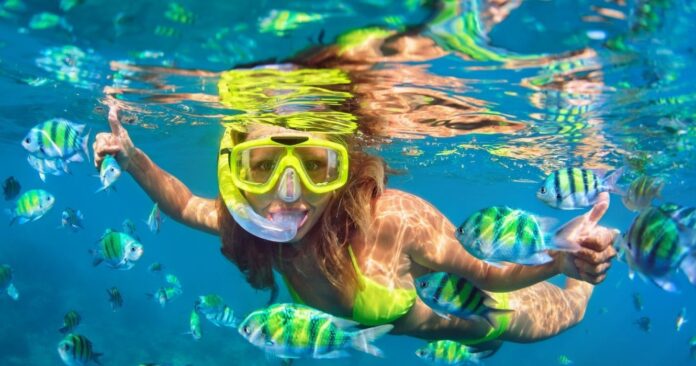The ocean and its treasures are some of the most beautiful elements of planet earth, and exploring it in real life is even more surreal.
With vibrant coral reefs that house myriads of colorful marine species — as well as creatures weird and wonderful — the sea is one of the very best samples of what mother nature can do when left to do what she does best.
And what nature does is craft immense ecosystems flourishing with all manners of lifeforms that complement one another as a thriving collective.
THETRAVEL VIDEO OF THE DAY
Today, it’s known that the ocean comprises around 71% of the Earth’s surface and is the world’s largest ecosystem containing 99% of all habitable space on the planet. The five chief ocean basins, the Pacific, Atlantic, Indian, Arctic, and Southern Oceans collectively house 94% of the Earth’s wildlife and a massive 97% of all the water on the blue planet.
However, despite how sensational and irresistibly fascinating, the ocean, its habitats, and its sea-dwellers big and small are, along with the major role the blue portion of the planet plays, humans still know very little about it.
The vast majority of the ocean remains unexplored and unseen by human eyes, with only about 5% of the ocean having been discovered and charted by people. The rest remains a mystery, and no matter how much mere mortals attempt to imagine its inexplicable vastness, size, and unreachable depths, it’s simply not a doable feat.
From kaleidoscopic reefs beating with life and extraordinary creatures of all shapes and sizes to jaw-dropping topographies like caves, submerged mountains, and even historic shipwrecks now taken over by ocean critters, there is so much to see under the water.
Fortunately, snorkeling offers a glimpse into those depths.
Why Go Snorkeling?
The explored and seen parts of the ocean that humans do know are nothing short of mesmeric and extraterrestrial.
It cannot be denied that the ocean is one of the planet’s most spectacular offerings — and it’s perfect for exploration. Atop the to-do list in terms of ocean activities is always snorkeling, an enjoyable pastime that’s open to all without the need for training or qualifications, unlike scuba diving.
Putting on a mask, snorkel, and fins allows people to explore the amazing alien worlds that bustle beneath the ocean’s surface, soaking up sights, sounds, and sub-sea scenery that’s only visible off the land.
Given the extreme expanse of the sea across the planet, there are countless places to snorkel, each providing utterly unique samples of marine life and seascapes. From snorkeling in the tropics to the icy arctics, in-water exploration is wonderful all over the world.
But some destinations are better than others, a fact that’s now evidenced by an intriguing new study undertaken by Bounce, whose teams analyzed the world’s seas on several factors, including coral reef areas, fish species, plastic waste production, and available snorkeling tours, all to come up with a final ranking indicating numerous countries’ official position on their data-driven list.
Why did they do this? To reveal the uncontested best countries for snorkeling around the world, of course!
What Reduces Snorkeling Quality?
As part of their research, Bounce gathered data from various sources to determine an accurate list of the best places to snorkel in the world.
With several defining factors at play, many of which consist of variables that lower the quality of a snorkeling destination, the team fathomed from their findings the places around the planet with the highest quality snorkeling — and the following aspects were what worked against a location ranking higher on the list:
Plastic In The Ocean
Ocean conservation has never been more crucial than it is at present as coral reefs and marine species are under threat due to pollution. In particular, it’s plastic waste that poses an enormous problem, clogging the oceans and harming the life within them, which, logically, lowers the quality of snorkeling and diving (but that’s the least of the issues, though).

Snorkeling is only possible with clean and healthy surface oceans that provide habitats for reefs and all kinds of marine flora and fauna.
Worryingly, recent data has shown the volume of plastic on the ocean’s surface is increasing at a rate of 5.14% annually.
Furthermore, as of 2020, there was just shy of twice as much macro-plastic in the surface oceans as there were micro-plastics, with a grand total volume of plastic at an unfortunate and sobering 1,730,000 tons.
Coral Reef Bleaching
In addition to plastic pollution sabotaging the world’s snorkeling experiences and harming wildlife, coral reefs are enduring bleaching events far more frequently than ever before.
When corals are exposed to severe water temperature increases, they expel algae, which they need for sustenance and energy. In turn, the corals starve and turn white as a result of algae loss, hence the term ‘bleaching’.
Luckily, coral reefs can recover from bleaching; however, it takes a long time for them to do so — around ten to 15 years for intense bleaching events at least.

Since the rate of coral bleaching events is increasing as climate change warms the oceans, there likely won’t be enough time between bleaching bouts for corals to recover and many will, unfortunately, die for good.
When Bounce evaluated the most recent data pertaining to coral bleaching, they found the world’s coral reefs suffered a staggering 238 bleaching events in the decade between 2006 and 2016 — and out of these 238 occurrences, more than half were classed as severe wherein over 30% of reef corals were damaged.
In summarized numbers, the team also discovered through the data that global coral reefs experienced an average bleaching event annual increase of 43% in the same ten years, indicating the problem is more serious than previously thought.
With these numbers in mind, which parts of the planet’s oceans experienced the severest coral bleaching instances?
1. Indian Ocean / Middle East
The Indian Ocean’s coral reefs endured a year-on-year increase of 147% in bleaching incidents — a number showing bleaching events more than doubled on average each year from 2006 to 2016. Sadly, 61% of the decade of total bleaching events were considered severe.
2. Australasia
Australasia’s coral reefs also saw their yearly bleaching events more than double each year in the same time period with a 125% year-on-year increase. In fact, this figure is worryingly higher than the average increase in bleaching events suffered by coral reefs on a global scale.
What’s more, 61% of the total bleaching events over the ten-year timeframe were deemed severe.
3. Pacific
The Pacific area had a lower rate of increase in bleaching incidence than the worldwide baseline of 43%.
Although this rate is slightly lower than in other regions, the number of coral reef bleaching events in the Pacific is still growing at a stark rate, with the region suffering a 40% annual increase in total bleaching events.
Also, 67% of the area’s ten-year total bleaching events were considered severe.
4. West Atlantic
Overall, the coral reefs in the West Atlantic experienced the lowest rate of increase in bleaching events with an average of 28%, but they still suffered the second-highest number of occurrences over the decade in question.
The only positive that can be drawn from this region’s bleaching rates is that just 23% were classed as severe.
The World’s Best Snorkeling Destinations
Despite limiting factors that depreciate the snorkeling experience and the health of marine life, some locations around the world possess aspects that are deemed good, and thus, snorkeling quality, which placed them on Bounce’s list of the best places to snorkel around the world.
In short, the redeeming qualities of the best countries for snorkeling consisted of available snorkeling tours, numbers and populations of fish species (including threatened specimens), percentage of plastic waste (the lower, the better), and the overall area of coral reef, among others.
Even though all the top snorkeling areas still suffer from some modern-day woes of pollution, coral bleaching, and species death, many of them do offer some truly amazing underwater life that’s abundant and healthier than others.
These nations and their waters branded best by Bounce are:
1. Australia

- Snorkeling rating: 8.23/10
- Coral reef area: 48,960 km2
- Fish species: 4,934
- Threatened fish species: 125
- Snorkeling tours: 97
- % of global plastic waste emission: 0%
- Sea temperature spread: 12.41° C
According to the factors in the data investigated by Bounce, Australia is the world’s best place to visit for snorkeling, boasting a superb snorkeling rating of 8.23 out of 10. This is no surprise since Australia is the home of the second-largest area of coral reef on the planet, the world-renowned Great Barrier Reef, with Cairns being the best city for access.
This vast aquatic expanse just is under 49,000 km2, which to put into perspective, comprises around 17.22% of the globe’s total coral reef area, making it an incredibly important portion of the sea.
Furthermore, Australia contributes 0% to global plastic waste emission, thereby actively keeping the oceans clean.
2. The Maldives

- Snorkeling rating: 7.33/10
- Coral reef area: 8,920 km2
- Fish species: 1,122
- Threatened fish species: 24
- Snorkeling tours: 18
- Share of global plastic waste emission: 0%
- Sea temperature spread: 0.45° C
The Maldives stands in second place on the podium for being the world’s number-two top snorkeling destination. The Maldives has almost 9,000 km2 of coral reefs, a number equating to 3.14%% of the planet’s total coral reefs.
Overall, the Maldives scored 7.33 out of 10 for snorkeling, with more than 1,100 unique fish species to spot coupled with a low sea temperature spread of 0.45° C — the latter meaning swimmers get to bask in year-round warm waters that only command a thin wetsuit at most for snorkeling and diving.
3. Cuba & The United States

- Snorkeling rating: 7.14/10
- Coral reef area: 3,020 km2
- Fish species: 1,103
- Threatened fish species: 44
- Snorkeling tours: 46
- % of global plastic waste emission: 0%
- Sea temperature spread: 1.81° C

- Snorkeling rating: 7.14/10
- Coral reef area: 3,770 km2
- Fish species: 3,074
- Threatened fish species: 251
- Snorkeling tours: 311
- % of global plastic waste emission: 0.25%
- Sea temperature spread: 3.8° C
Third place on the list of the top snorkeling destinations in the world has room for two; Cuba and the USA achieved joint number three, thanks to their amazing snorkeling experiences among other factors.
Cuba takes home a snorkeling rating of 7.14 out of 10 while offering a decent area of coral reef totaling 3,020 km2 and a diverse array of fish species and endangered fish species.
As a plus, Cuba also contributes 0% to the world’s plastic waste emissions, thus solidifying its place in the ranks as a slightly greener destination. 46 snorkeling tours are also on offer in Cuba, where the inviting ocean temperatures rest rather consistent ranging between 27.5° C and 30.53° C all year round.
As for The United States, its waters contain the seventh-highest number of fish species across 50 countries, while at the same time boasting the third-largest coral reef system on the planet — the world-famous Florida Reef.
The country also offers 311 snorkeling tours, providing ample in-water exploration opportunities to its guests, while contributing only 025% of the world’s plastic waste emission.
Amazingly, it’s not just the US’s huge variety of fish species that make for rich snorkeling experiences, but it’s also the high number of threatened fish species inhabiting its waters, too.
Where Is The World’s Best Snorkeling?
With all the above-explained contributing variables that constitute a country having top-tier snorkeling, people can discover who is next on the long list of the world’s best snorkeling destinations.
Using the same criteria to discern the winning three, Bounce employed their data to uncover this lengthy roster of the planet’s snorkeling regions, uncovering the best in descending order based on stats and facts that either boost or reduce the snorkeling experience.
So, whether it’s out of pure curiosity or to plan a dream vacation snorkeling and diving the world’s best sites, check out the following list and pick the places for that wondrous aquatic escapade — and choose wisely, taking into account the governing rank placement factors that appeal the most.











